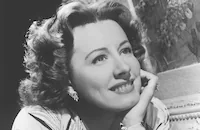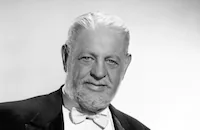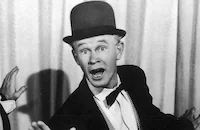Theodora Goes Wild

Brief Synopsis
Cast & Crew
Richard Boleslawski
Irene Dunne
Melvyn Douglas
Thomas Mitchell
Thurston Hall
Elisabeth Risdon
Film Details
Technical Specs

Synopsis
When the Lynnfield Bugle , a small Connecticut newspaper, runs a serial of Caroline Adams' risqué novel, The Sinner , editor Jed Waterbury receives many complaints from the puritannical townspeople. Among the outraged readers are leading citizens, Mary and Elsie Lynn, whose niece Theodora is the secret author of the scandalous novel. The literary circle, led by Mary, Elsie and straight-laced Rebecca Perry, force Jed to stop printing The Sinner . Soon after, under the pretext of visiting her Uncle John, the family's fun-loving black sheep, Theodora goes to New York to see her publisher, Arthur Stevenson. Stevenson is thrilled to be handling Theodora's best seller, but is frustrated by her refusal to participate in any publicity. Theodora, a Sunday school teacher and church organist, explains that although she wrote the novel as a mental escape from her stuffy existence, she would never dream of disgracing the family name by revealing that she is Caroline Adams. Theodora meets Stevenson's wife Ethel and also Michael Grant, the sophisticated artist who designed her book's cover. The four go out to dinner, during which Michael teases Theodora about her apparent lack of worldliness. Determined to act as she thinks Caroline Adams should, Theodora gets drunk and goes with Michael to his apartment. Theodora flees after being frightened by Michael's advances, and the illustrator chuckles to himself as his suspicions about her naïveté are confirmed. Back in Lynnfield, Michael, using the name Dubarry, arrives at Theodora's house and insists that she hire him as a gardener. Theodora quickly falls in love with him, and when the couple spend a morning picking berries, Michael tells her that she must break away and be herself. After they return to town, Theodora realizes that it is Sunday and she has forgotten her church duties. Later that night, Mary and Elsie are further scandalized when Theodora announces that she loves the gardener. The next morning, Michael returns to New York, and Theodora follows him. He confesses that he also loves her, but their conversation is interrupted by the arrival of his father Jonathan, who is the lieutenant governor, and Michael's wife Agnes, from whom he has been estranged for five years. Michael explains to Theodora that he cannot divorce Agnes because it would damage his father's career, but he promises Theodora that they can be married in two years, after his father retires. Determined to force Michael into action, Theodora moves into his apartment, after which he immediately moves out. Theodora then calls Stevenson and demands that her identity be revealed. The revelation stuns Lynnfield, but Theodora is not satisfied, and holds a press conference in Michael's apartment. While Theodora's aunts decide that she has "gone wild," Ethel, jealous of Theodora's notoriety, pronounces her to be "innocence on the manhunt." Later, Theodora escorts a drunken Stevenson to his home, and after Ethel sees them together, she files a divorce suit and names Theodora as the co-respondent. Ethel withdraws the suit, but Theodora creates a further uproar when she attends the governor's reception and reporters photograph Michael giving her a goodbye kiss. While Agnes is suing Michael for a divorce, Theodora returns to Lynnfield. Theodora brings with her the baby of Rebecca's daughter Adelaide, whom Theodora helped to secretly marry her sweetheart, Roger Taylor. Everyone in town assumes that the infant is Theodora's, and Michael, who has come to tell her that he is now free, also believes that she is the mother. Theodora then reveals that the baby is Adelaide's, and affectionately calls Michael an idiot when he embraces her.

Director

Richard Boleslawski
Cast

Irene Dunne

Melvyn Douglas

Thomas Mitchell

Thurston Hall

Elisabeth Risdon
Margaret Mcwade

Spring Byington

Nana Bryant

Henry Kolker

Leona Maricle
Robert Greig
Frederick Burton
Rosalind Keith
Mary Forbes
Grace Hale
Sarah Edwards

Mary Maclaren
Wilfred Hari
Laura Treadwell
Corbet Morris
Ben F. Hendricks
Frank Sully
James T. Mack

William Benedict
Carolyn Lee Bourland
Paul Barrett
Leora Thatcher
Billy Wayne
Harold Goodwin
Jack Hatfield
Harry Harvey
Don Brody
Eddie Fetherston
Ed Hart

Lee Phelps
Sherry Hall
Ralph Malone
Beatrice Curtis
Maurice Brierre
Sven Borg
Rex Moore
Georgia Cooper
Jane Keckley
Jessie Perry
Noel Bates
Betty Farrington
Stella Adams
Isabelle Lamal
Georgia O'dell
Dorothy Vernon

Bud Flannigan
Crew
Sidney Buchman
Harry Cohn
George Cooper
Stephen Goosson
Mary Mccarthy
Otto Meyer
William E. Mull
Bernard Newman
Everett Riskin
Morris Stoloff
Joseph Walker

Photo Collections
Videos
Movie Clip



Film Details
Technical Specs

Award Nominations
Best Actress
Best Editing
Articles
Theodora Goes Wild
Irene Dunne plays Theodora, a church organist in a small and stuffy Connecticut town, who secretly writes a racy best-selling novel. In New York for a meeting with her publisher, she gets involved with the illustrator of her book, played by Melvyn Douglas. Theodora then proceeds to scandalize hometown gossips, Douglas' politically prominent family, and even sophisticated New Yorkers, in her pursuit of true love.
Dunne had begun her career in musical theater, starring as Magnolia in the touring company of Show Boat in 1929. With the advent of sound films, she was among the many theater actors signed to a film contract. But by the time she arrived in Hollywood in 1930, the craze for musicals was over, so she began making a string of romantic melodramas, including Back Street (1932), and the Western epic Cimarron (1931), which earned her a Best Actress Academy Award nomination. A few years later, musicals made a comeback, and she starred in several, including Roberta (1935), and the film version of Show Boat (1936). Just before making the latter film, Dunne, dissatisfied with her RKO contract, decided to go freelance and signed a three-picture deal with Columbia. The studio chose Theodora Goes Wild as her first film, to Dunne's dismay. "I'd never done a comedy before," she later recalled. "I'd done serious parts like Back Street, and there was this little flipperty small town dummy, and I just didn't like her at all." Dunne took off for a two-month European vacation, hoping the studio would come up with something else when she returned. But by 1936, the screwball craze was in full swing, and all the dramatic stars, from Stanwyck to Davis to Crawford, were having a go at it. Columbia executives were adamant: either play Theodora, or go on suspension. Dunne acquiesced.
The director Columbia had chosen for Theodora Goes Wild was just as unlikely as its star. Polish director Richard Boleslawski was a product of Konstantin Stanislavsky's Moscow Art Theater and New York's experimental Laboratory Theater. In Hollywood since 1930, he had been directing prestige epics like Rasputin and the Empress (1932) and Les Miserables (1935). Dunne felt that Boleslawski had no flair for comedy, although she got along well with him, and enjoyed making the film. And according to co-star Melvyn Douglas, the director had his own wild side. Dunne was supposed to make an entrance appearing excited, but Boleslawski wasn't satisfied with her reactions. So he had a crew member fire blanks from a pistol just below Dunne's backside. Her entrance was appropriately flustered. Dunne recalled that Boleslawski was ill during much of the production. He died the following year, at the age of 48.
Like Dunne, Douglas had come to Hollywood from Broadway in 1931, and spent several years as a dramatic leading man to high-powered actresses like Gloria Swanson, Greta Garbo, and Barbara Stanwyck. Theodora Goes Wild, he said later, was the film that earned him "an international reputation for being one of the most debonair and witty farceurs in Hollywood...and a salable commodity." For the next 40 years, Douglas went back and forth between stage and screen, segueing easily into character parts as he aged.
Dunne and Douglas' expert playing, a superb group of character actors in supporting roles, Boleslawski's fast-paced direction, Sidney Buchman's witty script, and Bernard Newman's over-the-top costumes all contributed to making Theodora Goes Wild a huge hit with audiences. Critics, surprisingly, were less enthusiastic. Several compared the film to Frank Capra's Mr. Deeds Goes to Town (1936), and found it lacking. "Theodora is no match for Longfellow Deeds in sound, honest, homespun humor," harrumphed Frank Nugent in the New York Times, missing the point. "Although she goes wild, she also goes silly."
The Variety critic, however, noted that Dunne "takes the hurdle into comedy that so many dramatic actresses have made in the last year or two with versatile grace." Oscar® voters agreed, nominating Dunne for her second Best Actress Academy Award. In later years, critic Pauline Kael noted that "Irene Dunne was better in comedy than in her smug, sacrificial roles, and in [Theodora Goes Wild]...she was at her best. She's too bright - she's almost shrill in her brightness - and she does something clever with her teeth that makes one want to slap her, but she has energy, and this comedy...has a corny vitality that almost passes for wit."
Theodora Goes Wild also received an Oscar® nomination for editing. Although Dunne did not win (she would be nominated five times without winning), Theodora Goes Wild changed her career direction. Over the next few years, Dunne would reach the height of her popularity with such comedy classics as The Awful Truth (1937), Love Affair (1939), and My Favorite Wife (1940).
Director: Richard Boleslawski
Producer: Everett Riskin
Screenplay: Sidney Buchman, based on a story by Mary McCarthy
Cinematography: Joseph Walker
Editor: Otto Meyer
Costume Design: Bernard Newman
Art Direction: Stephen Goosson
Music: Morris Stoloff
Principal Cast: Irene Dunne (Theodora Lynn), Melvyn Douglas (Michael Grant), Thomas Mitchell (Jed Waterbury), Thurston Hall (Arthur Stevenson), Rosalind Keith (Adelaide Perry), Spring Byington (Rebecca Perry), Elisabeth Risdon (Aunt Mary), Margaret McWade (Aunt Elsie), Nana Bryant (Ethel Stephenson).
BW-94m.
by Margarita Landazuri

Theodora Goes Wild
Theodora Goes Wild - Irene Dunne in THEODORA GOES WILD, a Highlight of the New Icons of Screwball Comedy DVDs
She is excellent here, in Theodora, and interestingly the film has her start out playing things straight, only to undertake a dramatic shift halfway through the proceedings and become a zany screwball heroine. The movie itself, then, eases Dunne into her new persona. She plays Theodora Lynn of the small conservative town of Lynnfield, Conn. Little do her two spinsterly aunts, neighbors or anyone else know that she is also the author "Caroline Adams," whose racy bestseller The Sinner is being serialized in the local paper much to the outrage of the Lynnfield literary circle - of which Theodora is a member. The little old literary ladies condemn the book -- while enthusiastically reading it, of course -- and demand that the newspaper editor (Thomas Mitchell) cease publication.
Meanwhile, Theodora goes to New York to meet with her own publisher and ends up unwillingly charming her book's illustrator, Michael (Melvyn Douglas), who tries and fails to seduce her. Michael senses something fishy going on and tracks her back to Lynnfield, where upon threatening to expose her he moves into her shed and pretends to her aunts and everyone else to be a gardener. He encourages her to cut Lynnfield loose and liberate herself - in short, to "go wild." When she does just that, he gets more than he bargained for and the comedy is taken to a whole new level; the film itself is "liberated," becoming breathless and madcap. Theodora Goes Wild has its moments of clowning and is filled with hilarious dialogue, but beneath the surface there lurks a truly funny story, with comic situations building in scene upon scene with great precision and care.
The expertly constructed screenplay by Mary McCarthy and Sidney Buchman presents varying combinations of the main theme. Dunne hides her true self while pretending to be something she's not, and in the course of things "switches," by "going wild." Douglas goes in the opposite direction. That both characters go through their own ruses ends up uniting them for the audience and is why we see them as right for each other. All the while, Theodora Goes Wild works as a social satire with tremendous relevance even today. Hypocrisy on the part of those who would suppress or condemn on moral grounds is with our society as much as ever, if not more so, and it doubtless always will be.
Theodora has a fine supporting cast including Robert Greig, refreshingly seen playing something other than a butler, as well as Spring Byington and a most entertaining dog and cat, all three of whom are given one of the movie's funniest slapstick scenes.
Irene Dunne, in a 1978 interview with author James Harvey, said she found this film "unsophisticated" and professed amazement that it became such a success. Dunne thought Theodora was a "little small-town dummy... She's supposed to have gone wild, but she didn't go very wild really." Imagine the amazement Dunne must have felt when she received an Oscar nod for this role, her second of five Best Actress nominations. (She never did win the award.)
Theodora Goes Wild is in the new "Icons of Screwball Comedy, Volume Two" DVD collection from Sony Pictures Home Entertainment. There's also a "Volume One," of course, sold separately, and each volume contains four films on two discs apiece - for a total of four discs and eight films. You'd never know it from the packaging, but the two titles on each disc star the same leading lady. There's Irene Dunne, with Theodora Goes Wild and Together Again (1944), Loretta Young with The Doctor Takes a Wife (1940) and A Night to Remember (1943), Jean Arthur with If You Could Only Cook (1935) and Too Many Husbands (1940), and Rosalind Russell with My Sister Eileen (1942) and She Wouldn't Say Yes (1945). For some bizarre reason, not even the names of these actresses are on the DVDs' front covers, and there is no indication of the themed pairings. Furthermore, the cover art is unappealing in its color and design. Why Sony didn't just do something with the films' original poster art is puzzling.
The lack of audio commentaries is sadly de rigueur these days, as studios cut way back on their production expenses, but these discs have no extras of any sort save for one cartoon in each volume and some trailers. All this being said, one hesitates to criticize Sony, as the studio is at long last finally starting to put more of its catalogue titles on DVD. Coming in the months ahead are of volumes of film noir, horror, Sam Fuller, and Rita Hayworth. To see these eight, relatively "unimportant" screwball comedies being released is a real delight, and Sony deserves credit for digging a little deeper into its vaults. Picture and sound quality are pretty good throughout these discs, though none of the films has received a true restoration.
Of the other seven films here, If You Could Only Cook and Together Again make especially strong impressions. The latter is an excellent showcase for Irene Dunne and Charles Boyer, who made a superb co-starring team in three films including the classic Love Affair (1939). Here, Boyer plays a Manhattan sculptor who comes to Dunne's Vermont town to build a new statue, in a story that's somewhat similar to Theodora. It's also low-key, well-crafted and utterly charming.
For more information about Theodora Goes Wild (only available as part of the Icons of Screwball Comedy, Vol.2), visit Sony Pictures. To order Theodora Goes Wild, go to TCM Shopping.
by Jeremy Arnold
Theodora Goes Wild - Irene Dunne in THEODORA GOES WILD, a Highlight of the New Icons of Screwball Comedy DVDs
Quotes
Trivia
Notes
Information in the MPAA/PCA Collection at the AMPAS Library reveals that Columbia first submitted the script to the PCA in March 1936. However, the PCA rejected the script because it violated several tenets of the Code. In a letter to Harry Cohn, PCA president Joseph I. Breen details the various elements in violation of the Code: The heroine, Theodora, exemplifies "evil made to appear attractive" after she breaks up two marriages; all the "decent" and "church-going" characters are "made to appear ridiculous, stupid and silly" when compared with their city counterparts, who "indulg[e] in extra-marital activities, drunkenness and debauchery, [and] are made to appear attractive." A second revised script was submitted to the PCA in April 1936 and was met with approval. Hollywood Reporter production charts include Marian Marsh in the cast, however, her participation in the film has not been confirmed. According to modern sources, Irene Dunne resisted making this film because it was a comedy, however, Columbia insisted that it be the first film to fulfill her new contract with them. Modern sources point to this film as being a seminal film in the screwball comedy genre. Theodora Goes Wild was nominated in the following categories for Academy Awards: Best Actress, Irene Dunne, and Film Editing, Otto Meyer.

Miscellaneous Notes
Released in United States 1936
Released in United States January 1990
Released in United States May 2001
Shown at Cannes Internatiaonal Film Festival (Retrospective) May 9-20, 2001.
Released in United States May 2001 (Shown at Cannes Internatiaonal Film Festival (Retrospective) May 9-20, 2001.)
Released in United States 1936
Shown at Palm Springs Film Festival January 10-14, 1990.
Released in United States January 1990 (Shown at Palm Springs Film Festival January 10-14, 1990.)













